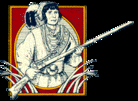|
SEMINOLE NATION, I. T.'The land between the rivers' Seminoles: A People Who Never Surrendered The Seminole are classified among the Muskogean peoples, a group of remnant tribes having joined in forming this division in Florida during the border wars between the Spanish and the English colonists on the Florida-Carolina frontier in the 18th century. The name Seminole, first applied to the tribe about 1778, is from the Creek word 'semino le', meaning 'runaway,' meaning emigrants who left the main body and settled elsewhere. In 1817, with the accusation that the Seminole were harboring runaway slaves, Andrew Jackson commanded nearly 3,000 troops to attack and burn the town of Mikasuki, starting the first Seminole War. Shortly thereafter, Spain ceded Florida to the U.S., bringing the Seminole under U.S. jurisdiction. A treaty later provided the tribe with a reserved tract east of Tampa Bay. In 1832, the Payne's Landing Treaty took away all Florida land claims from the tribe, and provided for removal to Indian Territory. Ratification of that treaty in 1834 allowed the Seminole three years before the removal was to take place. But under the U.S. government's interpretation, 1835 (not 1837) ended the three year period prior to removal. The Seminole disagreed, and their bitter opposition resulted in the second, or Great Seminole War. Among the worst chapters in the history of Indian Removal, the war lasted almost seven years and cost thousands of lives. It finally ended in 1842 with the agreement that several hundred members of the tribe could remain in Florida. They stayed in the Florida swamps but never surrendered. Their descendants are the Seminole in Florida today. No people have fought with more determination to retain their native soil, nor sacrificed so much to uphold the justice of their claims. Removal of the tribe from Florida to the Canadian Valley was the bitterest and most costly of all Indian removals. Indian Territory As tribal leaders surrendered during the war, their followers immigrated to the Indian Territory under military escort. The first were led by Chief Holahti Emathla in the summer of 1836. His party, who had lost many of their number by death during the two month journey, located north of the Canadian River, in present Hughes County. Their settlement was known by the name of their influential leader, Black Dirt (Fukeluste Harjo). In June, soon after the arrival of Chief Mikanopy at Fort Gibson, council was held with the Creek of the Lower Towns. When the matter of location of the Seminole was discussed, Chief Mikanopy and the Seminole leaders refused to settle in any part of the Creek Nation other than the tract assigned them under the treaty of 1833. A treaty signed by the U.S., and delegations of the Seminole and Creek Nations in 1845 paved the way for adjustment of the trouble that had arisen between the two tribes. The Seminole could settle anywhere in the Creek country, they could have their own town government, but under the general laws of the Creek Nation. No people have fought with more determination to retain their native soil, nor sacrificed so much to uphold the justice of their claims. Removal of the tribe from Florida to the Canadian Valley was the bitterest and most costly of all Indian removals. By 1849 the Seminole settlements were located in the valley of the Deep Fork south to the Canadian in what is now the western part of Okfuskee and Hughes counties, and neighboring parts of Seminole County. The revered Chief Mikanopy, who represented the ancient Oconee, died in 1849. He was succeeded by his nephew, Jim Jumper, who was soon succeeded by John Jumper, who came to Indian Territory as a prisoner of war. He became one of the great men in Seminole history and ruled as chief until 1877, when he then resigned to devote all his time to his church. Wild Cat, the principal advisor to Chief Mikanopy during his last years, never accepted being under the rule of the Creek Nation. Although his views won out in the end under the Treaty of 1856, he made no profit from it, because six years earlier he left the Indian Territory to start a Seminole colony in Mexico. By 1868, the refugee tribal bands were finally able to settle in the area that is known as the Seminole Nation. For the first time in 75 years they had a chance of establishing tribal solidarity. Their council house was built at Wewoka, designated capital of the Seminole Nation. When the Seminole people made their last settlement in Indian Territory, eight tribal square grounds were established in different parts of the nation where the old ceremonials, dances and ball games were held. Two of these square grounds were known as Tallahasutci or (Tallahasse) and Thliwathli or (Therwarthle). There is still a loose organization of the twelve Seminole "towns" or "bands" that were organized for political and geographical reasons in re-establishing the tribal government that had formerly existed in Florida. The Century Turns The Oklahoma Constitutional Convention divided all of Indian Territory into 40 counties, no county being exactly as the
| ||||||||||||||||||||||||||||||||||||||||||||||||||||||







